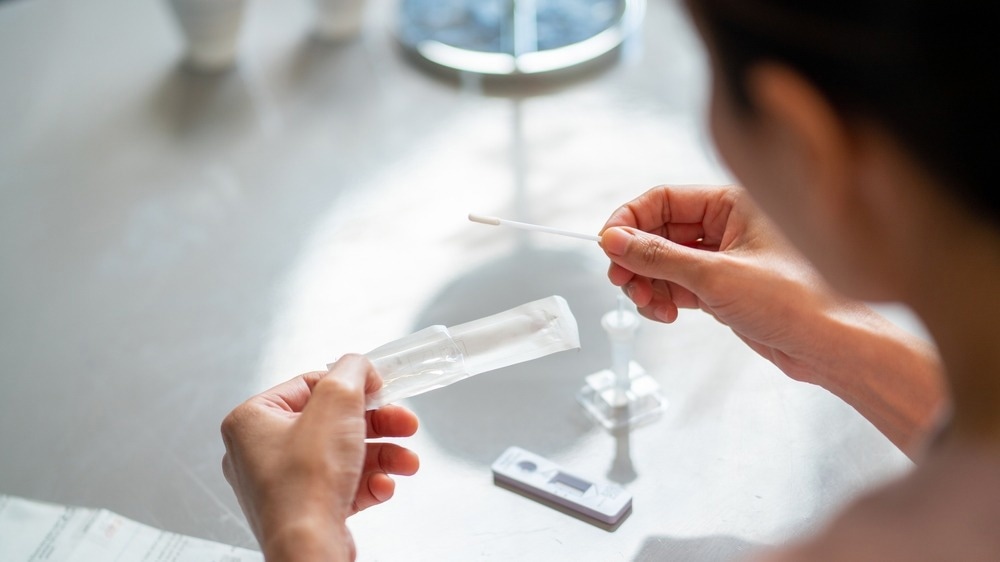In a recent study published in the journal PLoS ONE, researchers assess key attributes of rapid severe acute respiratory syndrome coronavirus 2 (SARS-CoV-2) testing that would enable self-testing for coronavirus disease 2019 (COVID-19) by individuals in the comfort of their homes.

Study: Is there a “price that’s right” for at-home COVID tests? Image Credit: CandyRetriever / Shutterstock.com
Background
The COVID-19 pandemic has caused unprecedented morbidity and mortality globally, the mitigation of which is challenged by the continual emergence of increasingly transmissible SARS-CoV-2 variants, such as Omicron and its subvariants. In December 2021, during which pressures to resume routine lives were mounting, various types of home-based COVID-19 tests were made available to the general public to expand testing capacity, increase convenience, and limit SARS-CoV-2 exposure.
On December 21, 2021, United States President Joe Biden announced that the government would distribute 500 million home-testing kits to Americans without any charges. By January 20, 2022, every U.S. resident could obtain four home-based rapid SARS-CoV-2 testing kits through the COVIDTests.gov portal distributed by the U.S. Postal Service with no added costs.
About the study
In the present study, researchers discuss the results of a December 2021 conjoint analysis using web-based surveys. A total of 583 individuals were provided with 12 home-based COVID testing concepts that varied by accuracy, price, time, method, and purchase mode of online or in stores.
The team distributed quantitative surveys online between December 10, 2021, and December 23, 2021, which was a period of SARS-CoV-2 testing deficit during the holiday surge in Omicron infections. By December 10, 2021, 13 home-based COVID-19 tests were available for purchase, each of which varied in their accuracy, price, turnaround time, purchase mode, and whether saliva or nasal samples were used for the analysis. Only U.S. residents over the age of 21 years were included in the analysis.
Data were obtained on individual age, sex, ethnicity, residential location, income, and educational status. In addition, individuals were asked about previous experiences with and their readiness for home-based COVID-19 testing.
The study comprised a conjoint or trade-off task, wherein individuals rated their probability of buying and using the 12 home-based testing concepts, to assess the values or utility assigned by individuals to the product characteristics.
A fractional-factorial-type algorithm was used to create 12 different profiles, whereas linear regression modelling was performed to estimate the impact of changes in each attribute’s value and part-worth analysis utility levels on home-based COVID-19 testing acceptability. Greater utility values were associated with a greater preference for the attribute level.
Results
The test price was the most critical attribute in user acceptability, as study participants were price-sensitive, with accuracy and rapid results also important attributes. Among the participants, 64% reported a willingness to take home-based COVID-19 tests; however, only 22% of respondents had previously used home-based testing kits.
Individuals 35 years and younger, especially men, were over-represented among individuals using home-based COVID-19 tests. Individuals with a bachelor’s degree or greater educational status were over-represented, with observed versus expected proportions of 52% versus 33%, respectively. In addition, individuals earning over $100,000 USD (observed 38% versus 21%) and those residing in urban regions (observed 61% versus the expected 36%) were over-represented.
Among those willing to take COVID-19 tests at home, older individuals were under-represented, with observed versus expected proportions of 20% and 26%, respectively. In the unwilling category, individuals earning less than $25,000 were over-represented at 32% versus the expected 23%. Among the 99 unsure individuals, rural residents were over-represented at 33% versus the expected 20%.
Increasing the test cost to $15.00 USD from $5.00 USD reduced utility by a part-worth value of 13. Likewise, increasing test accuracy to 98% from 85% enhanced utility by a part-worth value of 15.
However, changing the sampling technique to salivary sampling from nasal sampling improved test utility by only 2.1. The most desired attributes were a $5.00 USD price, 98% accuracy, a turnaround time of 15 minutes, saliva-based testing, and purchasing test kits from the stores.
Part-worth analyses indicated that even when the price of test kits increase to $15.00 USD and test precision to 98%, consumers would pay the price, as the utility values of tests priced at $15.00 USD with 98% accuracy were greater as compared to the values for the $5.00 USD and 85% accuracy tests. However, individuals would not pay $25.00 USD for a 98% accuracy test, as the utility values for these proposed tests were less as compared to the values for the $5.00 USD-priced 85% accuracy test.
Based on the importance weights, the mean importance values for price, accuracy, time, method, and purchase mode were 0.4, 0.2, 0.2, 0.1, and 0.1, respectively. Similar findings were obtained in the hierarchical cluster analysis. The mean importance values of test price among individuals willing, unwilling, and unsure to take the tests were 0.3, 0.4, and 0.4, respectively.
Conclusions
Removing price as a barrier to consumers could improve home-based COVID-19 test use. Individuals also value rapid and highly accurate results; however, specimen collection methods and purchase modes did not significantly impact test acceptability.
Overall, the study findings provide the most preferable testing configurations that must be optimized to increase SARS-CoV-2 testing rates without increasing SARS-CoV-2 exposure by home-based testing.
Journal reference:
- Kirby, R. P., Maimaran, M., & Palamountain, K. M. (2023). Is there a “price that’s right” for at-home COVID tests? PLoS ONE 18(3): e0282043. doi:10.1371/journal.pone.0282043